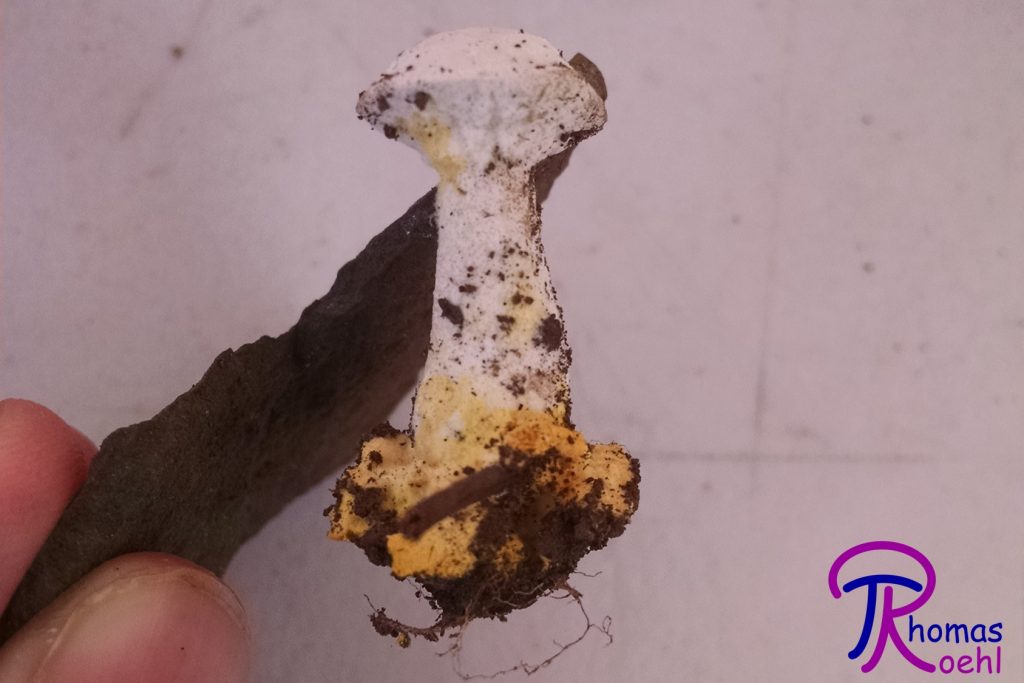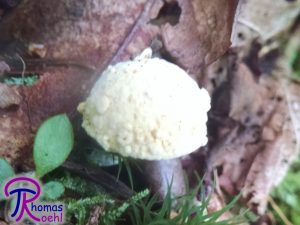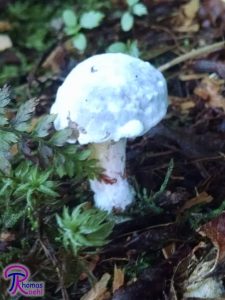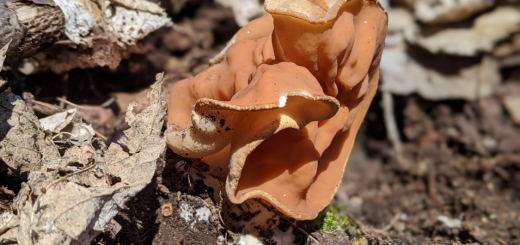#158: Hypomyces chrysospermus, the Bolete Eater

Hypomyces chrysospermus showing the white and yellow phases.
Occasionally, you encounter something that has the stature and shape of a bolete but is completely smooth underneath its cap. “What can this be?” you ask. “No crust fungi are this fleshy or have such a well-defined cap and stem.” It turns out that you did find a bolete, only it is being parasitized by another fungus! Hypomyces chrysospermus is a common parasite of all kinds of boletes. It forms a crust that often completely engulfs its host. The “Bolete Eater,” “Bolete Mold,” or “Golden Hypomyces” is easy to identify, thanks to its preference for boletes and its white to yellow color scheme.[i]
Description

The Bolete Eater transitioning into the yellow phase.
H. chrysospermus begins infecting its host on the pore surface, but soon spreads to other areas and often completely engulfs the mushroom. Sometimes, this causes the mushrooms to grow irregularly and results in bizarre shapes. The mold forms a smooth layer of mycelium over the mushroom that has a somewhat powdery texture. There are three distinct phases to the growth of the Bolete Eater, which are easily identified by the color of the mold: white, golden yellow, and reddish brown.[ii]
During the first phase, H. chrysospermus is white and fairly smooth. In my experience, the white phase is the smoothest phase. As a result, I usually can’t tell that an engulfed bolete has been parasitized until I flip it over to check the pore surface. During this stage, the fungus produces asexual spores (the way these develop makes them conidia) that are smooth, elliptic, and lack color.[iii]
The second phase sees the Bolete Eater take on a golden yellow color and become more powdery and lumpy. This does not happen all at once, so some areas of the mold may be yellow while others are still white. In this phase, H. chrysospermus begins producing asexual spores (the way these are produced makes them aleuriospores) that are round, yellow, and spiny to warty.[iv]
Finally, H. chrysospermus turns reddish-brown and develops a pimpled texture. Because the mushroom is well-decomposed at this point, the final stage is rarely seen or collected. The mushy texture of the mostly rotted mushroom also helps to discourage people from collecting it. This phase is characterized by the production of sexual spores, which are long and thin, warty, colorless, and divided into two cells by a septum.[v] H. chrysospermus is an ascomycete, so its sexual spores are produced inside cells called asci. These asci are found in flask-shaped structures called perithecia. Each ascus starts at the bottom of the perithecium and grows up to the small pore at the top, where it fires off its spores. The pimply texture of the mold during this phase is a result of the perithecia. Each perithecium has a pore that can be found at the center of a pimple.[vi]
Ecology

Hypomyces chrysospermus white phase
H. chrysospermus is a mycotroph of boletes, so it can be found growing on any kind of bolete (mushrooms in the family Boletaceae). It is particularly common on species in the genus Xerocomus.[vii] The Bolete Eater can also be found on mushrooms in the gilled mushroom genus Paxillus and the false truffle genus Rhizopogon.[viii] Both of these genera are related to the boletes, although they do not belong to the family Boletaceae.[ix] H. chrysospermus has a wide range and can be found throughout much of the world. In North America, its range includes the eastern part of the country as well as the west coast.[x] The Bolete Eater is more common during wet weather.[xi]
The “Gilled Boletes” (Phylloporus spp., FFF#187) can also be attacked by H. chrysospermus. As I have been told, this fact was significant for Phylloporus taxonomy before DNA testing was widely available. Because the Gilled Boletes could be attacked by the Bolete Mold, they must be boletes that developed gills rather than agarics that happened to look like boletes. DNA research has borne this out, and the Gilled Boletes are still considered to be related to the rest of the boletes.[xii]
Similar Species
Without a microscope, you actually can’t be sure that you’ve collected H. chrysospermus. Another bolete parasite, H. microspermus, looks exactly the same to the naked eye. You need a microscope to be able to differentiate between the two, and even then it may not be possible. H. microspermus, as its name suggests, has smaller spores than H. chrysospermus. The ascospores of H. microspermus are almost never longer than 15µm, whereas H. chrysospermus almost always produces ascospores longer than 20µm. Unfortunately, the range of sizes for the molds’ asexual spores overlap. On average, H. microspermus produces smaller asexual spores, but measuring asexual spore length may not help differentiate between the two species. A more useful feature for identification is that H. microspermus produces only round, spiny asexual spores, even during its white growth phase.[xiii]
See Further:
http://www.mykoweb.com/CAF/species/Hypomyces_chrysospermus.html
http://www.mushroomexpert.com/hypomyces_chrysospermus.html
http://www.svims.ca/council/Hypomy.htm#nHchr
http://www.rogersmushrooms.com/gallery/DisplayBlock~bid~6205.asp
Citations:
[i] Michael Kuo, “Hypomyces Chrysospermus (MushroomExpert.Com),” MushroomExpert.Com, February 2004, http://www.mushroomexpert.com/hypomyces_chrysospermus.html; Ian Gibson, “Notes on HYPOMYCES in the Pacific Northwest,” SVIMS.ca, 2008, http://www.svims.ca/council/Hypomy.htm.
[ii] Kuo, “Hypomyces Chrysospermus (MushroomExpert.Com).”
[iii] Michael Wood and Fred Stevens, “California Fungi: Hypomyces Chrysospermus,” MykoWeb, accessed September 16, 2016, http://www.mykoweb.com/CAF/species/Hypomyces_chrysospermus.html; Gibson, “Notes on HYPOMYCES in the Pacific Northwest.”
[iv] Wood and Stevens, “California Fungi: Hypomyces Chrysospermus”; Gibson, “Notes on HYPOMYCES in the Pacific Northwest.”
[v] Gibson, “Notes on HYPOMYCES in the Pacific Northwest.”
[vi] Wood and Stevens, “California Fungi: Hypomyces Chrysospermus.”
[vii] Ibid.
[viii] “Rogers Mushrooms – Hypomyces Chrysospermus Mushroom,” RogersMushrooms, accessed September 16, 2016, http://www.rogersmushrooms.com/gallery/DisplayBlock~bid~6205.asp.
[ix] Michael Kuo, “Mushroom Taxonomy (MushroomExpert.Com),” MushroomExpert.Com, March 2014, http://www.mushroomexpert.com/taxonomy.html.
[x] Gibson, “Notes on HYPOMYCES in the Pacific Northwest.”
[xi] Wood and Stevens, “California Fungi: Hypomyces Chrysospermus.”
[xii] Michael Kuo, “The Genus Phylloporus (MushroomExpert.Com),” MushroomExpert.Com, March 2005, http://www.mushroomexpert.com/phylloporus.html.
[xiii] Gibson, “Notes on HYPOMYCES in the Pacific Northwest”; Wood and Stevens, “California Fungi: Hypomyces Chrysospermus.”








![#011: Characteristics of Kingdom Fungi [Archived]](https://www.fungusfactfriday.com/wp-content/themes/hueman/assets/front/img/thumb-small-empty.png)

2 Responses
[…] by the fungus Hypomyces chrysospermus. H. chrysospermus (commonly known as “the Bolete Eater,” FFF#158) grows only on mushrooms related to boletes. It can parasitize some mushrooms from a few true […]
[…] its relatives (noted insect killers, see FFF#058), species of Hypomyces (they eat other fungi, see FFF#158), and Xylaria (such as Dead Man’s Fingers, FFF#005).9 Many of these species form perithecia that […]